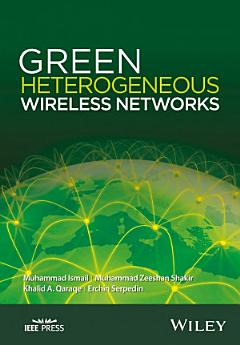Green Heterogeneous Wireless Networks
આ ઇ-પુસ્તક વિશે
The book is novel in that it specifically targets green networking in a heterogeneous wireless medium, which represents the current and future wireless communication medium faced by the existing and next generation communication networks. The book focuses on multi-homing resource allocation, exploiting network cooperation, and integrating different and new network technologies (radio frequency and VLC), expanding the network coverage and integrating new device centric communication paradigms such as D2D Communications. Whilst the book discusses a significant research topic supported with advanced mathematical analysis, the resulting algorithms and solutions are explained and summarized in a way that is easy to follow and grasp. This book is suitable for networking and telecommunications engineers, researchers in industry and academia, as well as students and instructors.
લેખક વિશે
Muhammad Ismail: Postdoctoral Research Associate, Electrical and Computer Engineering Department, Texas A&M University at Qatar, Doha, Qatar. Dr. Ismail’s area of expertise is related to radio resource allocation in a heterogeneous wireless medium. He is a co-recipient of the best paper award at IEEE ICC '14 for a paper related to green resource allocation in a heterogeneous wireless medium: M. Ismail, A. T. Gamage, W. Zhuang, and X. Shen, "Energy efficient uplink resource allocation in a heterogeneous wireless medium," IEEE ICC'14, (to be listed in IEEExplore).
Muhammad Zeeshan Shakir: Assistant Research Scientist, Electrical and Computer Engineering Department, Texas A&M University at Qatar, Doha, Qatar. Dr. Shakir's research interests include design and deployment of diverse green wireless communication systems including hyper-dense heterogeneous small-cell networks with particular focus on traffic offloading techniques and backhauling technologies. He has published more than 50 technical journal and conference papers and has contributed to 6 books.
Khalid Qaraqe: Professor, Electrical and Computer Engineering Department, Texas A&M University at Qatar, Doha, Qatar. Dr. Qaraqe has over 15 years of experience in the telecommunications industry. He has worked for Qualcomm, Enad Design Systems, Cadence Design Systems/Tality Corporation, STC, SBC and Ericsson. His research interests include communication theory and its application to design and performance analysis of cellular systems and indoor communication systems. Particular interests are in the development of 4G LTE, cognitive radio systems, broadband wireless communications and diversity techniques.
Erchin Serpedin: Professor, Electrical and Computer Engineering Department, Texas A&M University, College Station, Texas, USA. Dr. Serpedin is the author of two research monographs, one edited textbook, 100 journal papers and 180 conference papers, and has served as associate editor for approximately 12 journals including IEEE Transactions on Information Theory, IEEE Signal Processing Magazine, IEEE Transactions on Communications, and IEEE Communications Letters. His research interests include signal processing, wireless communications, computational statistics, and bioinformatics and systems biology. He is currently serving as editor in chief of the Eurasip Journal on Bioinformatics and Systems Biology, an online journal edited by Springer. He is also an IEEE Fellow.





